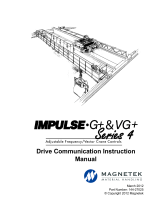
8
VLT is a registered Danfoss trademark
Address Field
The address field of a message frame
contains 8 bits. Valid slave device addresses
are in the range of 0 – 247 decimal. The
individual slave devices are assigned
addresses in the range of 1 – 247. (0 is
reserved for broadcast mode, which all slaves
recognize.) A master addresses a slave by
placing the slave address in the address field
of the message. When the slave sends its
response, it places its own address in this
address field to let the master know which
slave is responding.
Function Field
The function field of a message frame
contains 8 bits. Valid codes are in the range
of 1 – 255 decimal. When a message is sent
from a master to a slave device, the function
code field tells the slave what kind of action to
perform.
When the slave responds to the master, it
uses the function code field to indicate either
a normal (error-free) response, or that some
kind of error occurred (called an exception
response). For a normal response, the slave
simply echoes the original function code. For
an exception response, the slave returns a
code that is equivalent to the original function
code with its most-significant bit set to a logic
1. In addition, the slave places a unique code
into the data field of the response message.
This tells the master what kind of error
occurred, or the reason for the exception.
See the Exception Codes section in this
manual for definitions.
Data Field
The data field is constructed using sets of
two hexadecimal digits, in the range of 00 to
FF hexadecimal. These are made from one
RTU character. The data field of messages
sent from a master to slave device contains
additional information which the slave must
use to take the action defined by the function
code. This can include items like coil or register
addresses, the quantity of items to be handled,
and the count of actual data bytes in the field.
The data field can have a length of zero.
CRC Check Field
Messages include an error-checking field that
is based on a cyclical redundancy check
(CRC) method. The CRC field checks the
contents of the entire message. It is applied
regardless of any parity check method used
for the individual characters of the message.
The CRC value is calculated by the
transmitting device, which appends the CRC
as the last field in the message. The receiving
device recalculates a CRC during receipt of
the message and compares the calculated
value to the actual value received in the CRC
field. If the two values are not equal, a bus
timeout results.
The error checking field contains a 16-bit
binary value implemented as two 8-bit bytes.
When this is done, the low-order byte of the
field is appended first, followed by the high-
order byte. The CRC high-order byte is the
last byte sent in the message.
Coil/Register Addressing
All data addresses in Modbus messages are
referenced to zero. The first occurrence of a
data item is addressed as item number zero.
For example:
The coil known as ‘coil 1’ in a programmable
controller is addressed as coil 0000 in the
data address field of a Modbus message. Coil
127 decimal is addressed as coil 007E
HEX
(126
decimal).
Holding register 40001 is addressed as
register 0000 in the data address field of the
message. The function code field already
specifies a ‘holding register’ operation.
Therefore, the ‘4XXXX’ reference is implicit.
Holding register 40150 is addressed as register
0095
HEX
(149 decimal).
Modbus RTU
Message
Framing
Structure
(continued)




















